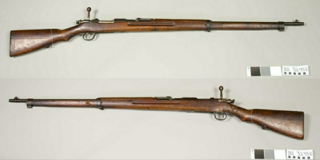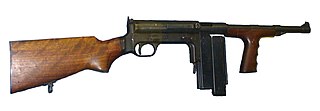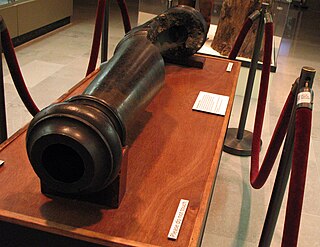
A submachine gun (SMG) is a magazine-fed, automatic carbine designed to fire handgun cartridges. The term "submachine gun" was coined by John T. Thompson, the inventor of the Thompson submachine gun, to describe its design concept as an automatic firearm with notably less firepower than a machine gun. As a machine gun must fire rifle cartridges to be classified as such, submachine guns are not considered machine guns.

The Thompson submachine gun is a blowback-operated, air-cooled, magazine-fed selective-fire submachine gun, invented by United States Army Brigadier general John T. Thompson in 1918. It was originally designed to break the stalemate of trench warfare of World War I, but was not finished until after the war ended.
The M14 rifle, officially the United States Rifle, Caliber 7.62 mm, M14, is an American selective fire battle rifle chambered for the 7.62×51mm NATO cartridge. It became the standard-issue rifle for the U.S. military in 1959, replacing the M1 Garand rifle in service with the U.S. Army by 1958 and the U.S. Marine Corps by 1965. The M14 was used by the U.S. Army, Navy, and Marine Corps for Basic and Advanced Individual Training (AIT) from the mid-1960s to the early 1970s.

The M4 carbine is a 5.56×45mm NATO, gas-operated, magazine-fed, carbine developed in the United States during the 1980s. It is a shortened version of the M16A2 assault rifle.

The Browning Automatic Rifle (BAR) is a family of American automatic rifles and machine guns used by the United States and numerous other countries during the 20th century. The primary variant of the BAR series was the M1918, chambered for the .30-06 Springfield rifle cartridge and designed by John Browning in 1917 for the American Expeditionary Forces in Europe as a replacement for the French-made Chauchat and M1909 Benét–Mercié machine guns that US forces had previously been issued.

Colt's Manufacturing Company, LLC is an American firearms manufacturer, founded in 1855 by Samuel Colt and is now a subsidiary of Czech holding company Colt CZ Group. It is the successor corporation to Colt's earlier firearms-making efforts, which started in 1836. Colt is known for the engineering, production, and marketing of firearms, most especially between the 1850s and World War I, when it was a dominating force in its industry and a seminal influence on manufacturing technology. Colt's earliest designs played a major role in the popularization of the revolver and the shift away from earlier single-shot pistols. Although Samuel Colt did not invent the revolver concept, his designs resulted in the first very successful ones.

The Heckler & Koch G3 is a 7.62×51mm NATO, select-fire battle rifle developed in the 1950s by the German armament manufacturer Heckler & Koch (H&K) in collaboration with the Spanish state-owned design and development agency CETME.

JSC Kalashnikov Concern, known until 2013 as the Izhevsk Machine-Building Plant, is a Russian defense manufacturing concern and joint-stock company headquartered in the city of Izhevsk in the Republic of Udmurtia as well as the capital city of Moscow. The concern designs and produces a wide range of civilian and military weapons including assault rifles, sniper rifles, designated marksman rifles, machine guns, squad automatic weapons, hunting rifles, shotguns, guided artillery projectiles, and a wide range of other precision weapons including remote controlled weapon stations, unmanned vehicles and military robots.

The M231 Firing Port Weapon (FPW) is an adapted version of the M16 assault rifle for shooting from firing ports on the M2 Bradley. The M16, standard infantry weapon of the time, was too long for use in a "buttoned up" APC, so the FPW was developed to provide a suitable weapon for this role. Designed by the Rock Island Arsenal, the M231 FPW remains in service, although all but the rear two firing ports on the Bradley have been removed.

The Type 30 rifleArisaka is a box-fed bolt-action repeating rifle that was the standard infantry rifle of the Imperial Japanese Army from 1897 to 1905.

The United Defense M42, sometimes known as the Marlin for the company that did the actual manufacturing, was an American submachine gun used during World War II. It was produced from 1942 to 1943 by United Defense Supply Corp. for possible issue as a replacement for the Thompson submachine gun and was used by agents of the Office of Strategic Services (OSS). However, its usage was limited, and the Thompson continued to see service until the end of the war, alongside the M3 submachine gun, which was designed around the same time as the M42.
The weapons master, sometimes credited as the armorer, weapons specialist, weapons handler, weapons wrangler, or weapons coordinator, is a film crew specialist that works with the property master, director, actors, stunt coordinator and script supervisor. The weapons master is specifically responsible for maintaining control of any prop weapons, including firearms, knives, swords, bows, and staff weapons.

The Liberty Arsenal, known by Federal authorities as the Missouri Depot was a United States Army arsenal at Liberty, Missouri in Clay County, Missouri. The depot was seized twice by Southern partisans, once during the Kansas troubles in 1855, and again shortly after the outbreak of the American Civil War. It was located generally west of the junction of Missouri Route 291 and old 210 Highway.

The Colt Model 1848 Percussion Army Revolver is a .44 caliber revolver designed by Samuel Colt for the U.S. Army's Regiment of Mounted Rifles. The revolver was also issued to the Army's "Dragoon" Regiments. This revolver was designed as a solution to numerous problems encountered with the Colt Walker. Although it was introduced after the Mexican–American War, it became popular among civilians during the 1850s and 1860s, and was also used during the American Civil War.

Astra Unceta y Cía was a Spanish weapons manufacturer founded on July 17, 1908, under the name Esperanza y Unceta by Juan Esperanza and Pedro Unceta. Initially based in Eibar, the centre of the Basque arms industry, the company moved in 1913 to Guernica.

The Internet Movie Firearms Database (IMFDb) is an online database of firearms used or featured in films, television shows, video games, and anime. A wiki running the MediaWiki software, it is similar in function to the Internet Movie Database for the entertainment industry. It includes articles relating to actors, and some characters, such as James Bond, listing the particular firearms they have been associated with in their movies. Integrated into the website is an image hosting section similar to Wikimedia Commons that includes firearm photos, manufacturer logos, screenshots and related art. The site has been cited in magazines such as the NRA's American Rifleman and True West Magazine and magazine format television shows such as Shooting USA on the Outdoor Channel.

An AR-15-style rifle is any lightweight semi-automatic rifle based on the Colt AR-15 design. The original ArmaLite AR-15 is a scaled-down derivative of Eugene Stoner's ArmaLite AR-10 design. The then Fairchild Engine and Airplane Corporation division ArmaLite sold the patent and trademarks to Colt's Manufacturing Company in 1959. After most of Colt's patents for the Colt AR-15 expired in 1977, many firearm manufacturers began to produce copies of the Colt AR-15 under various names. While the patents are expired, Colt retained the trademark of the AR-15 and is the sole manufacturer able to label their firearms as AR-15. The "AR" in Colt AR-15 stands for "ArmaLite Rifle", not "assault rifle".

The Colt First Model Ring Lever rifle and Colt Second Model Ring Lever rifle are two early caplock revolving rifles that were produced by the Patent Arms Manufacturing Company between 1837 and 1841. The First Model, produced between 1837 and 1838, was the first firearm manufactured by Samuel Colt, developed shortly before the advent of the Colt Paterson revolver. The First Model was succeeded by the Second Model, produced between 1838 and 1841, which featured minor variations in design and construction. Both models are distinguished from later Colt revolving long-arms by the presence of a small ring lever located in front of the trigger. This lever, when pulled, would index the cylinder to the next position and cock the internal hidden hammer. Although complicated in design and prone to failures, fifty First Model rifles were ordered by the U.S. Army for use against Seminole warriors in the Second Seminole War.

The American Committee for the Defense of British Homes was an American organization during World War II that donated weapons to help defend Britain from a potential German invasion. It was issued a State Department license to export weapons to a British civilian body. British government policy was against the participation of civilians in warfare and the Firearms Act 1937 made it illegal to distribute firearms to civilians. The ACDBH secured the support of Lord Beaverbrook and worked closely with his Ministry of Aircraft Production (MAP). Many of the weapons were used to arm MAP Home Guard units, despite the Home Guard being part of the British armed forces.
Griffin & Howe, Inc. is an American firearms manufacturer headquartered in Andover, New Jersey. Founded in 1923 by Seymour Griffin, a New York City cabinetmaker, and James V. Howe, foreman of the machine shop at the Frankford Arsenal in Pennsylvania.


















